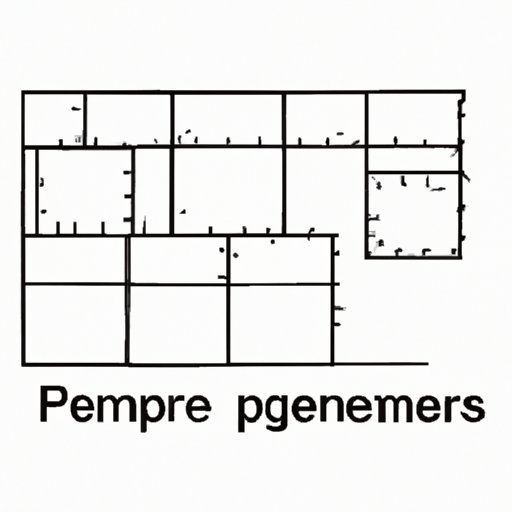
Introduction
The perimeter of a shape is the distance around its edge. It’s a crucial measurement used in various fields, including math, engineering, and architecture. Knowing how to calculate the perimeter of a shape is an essential skill that can come in handy in many situations, from DIY projects to everyday life.
Quick Tricks to Measure the Perimeter of Any Shape
Measuring the perimeter of a shape may seem daunting, but with some quick tricks, you can measure it easily. A string, ruler, or measuring tape can work for basic shapes like squares or rectangles. By using a string, you can wrap it around the shape’s edge and measure it using a ruler or measuring tape. Alternatively, you can estimate the perimeter by counting steps or arm lengths. For more regular shapes like triangles and rectangles, simple formulas can help you calculate the perimeter accurately.

Exploring the Basics of Perimeters and How to Calculate Them
The perimeter of any shape is the sum of its sides. Therefore, the formula for calculating perimeter is adding up the length of all the sides of the shape. For example, the perimeter of a rectangle can be calculated using the formula “2(l + w),” where “l” is the length and “w” is the width of the rectangle. Similarly, the perimeter of a triangle can be calculated by adding all three sides together. Let’s consider a triangle with sides a, b, and c. The formula for associating the perimeter of this triangle is “a + b + c.”
5 Easy Steps to Find the Perimeter of Regular Polygons
Regular polygons are polygons whose sides and angles are all equal. They include triangles, squares, and pentagons. To calculate the perimeter of regular polygons, you only need to know two things: the number of sides and the length of one side. The formula for calculating the perimeter of a regular polygon is “P = n × s,” where “P” is the perimeter, “n” is the number of sides, and “s” is the length of one side. Here are five easy steps to calculate the perimeter of a regular polygon:
- Count the number of sides
- Measure the length of one side
- Use the formula: P = n × s
- Substitute the values for “n” and “s” in the formula
- Solve for perimeter (P)
Perimeter: What It Is and How to Find It Like a Pro
Sometimes, finding the perimeter of a shape can be more complex than using a simple formula or counting steps. In those cases, some tips and tricks can help you with this task. Firstly, it’s essential to break the shape into smaller, simpler shapes to make your calculations easier. Secondly, it’s usually helpful to identify any congruent or parallel lines that make calculating the perimeter more straightforward. Finally, avoid common mistakes, such as forgetting to count all sides or using the wrong formula.
No Sweat! Here’s How to Find the Perimeter of Irregular Shapes
Irregular shapes can be more challenging to measure, but the same principles apply. Firstly, dividing the shape into smaller, simpler shapes can make calculations more manageable. Secondly, you can use the same formula as before, adding up all the sides’ lengths to get the perimeter. Lastly, be sure to double-check your count and calculations before arriving at a final answer.
Mastering Perimeters: How to Teach Children about Perimeter Calculation
Perimeter calculation is an important foundational skill that can help children later in their academic and professional lives. It’s also easy and fun to teach children through games and activities. For example, you can ask them to measure the perimeter of their toys or household objects using a string and ruler. You can also use interactive online tools or printable worksheets. It’s also essential to cater to different learning styles, such as visual or kinesthetic, to help children understand and internalize perimeter calculation concepts better.
From Squares to Circles: Different Methods to Find Perimeter of Geometric Shapes
The perimeter of geometric shapes can be calculated using various formulas. Different formulas are used for different shapes, for example, “P = 4s” for squares and “P = πd” for circles. To find the perimeter of a triangle, add up all three sides, as we previously discussed. Knowing the formulas for different geometric shapes can help you calculate the perimeter quickly and accurately.
Conclusion
In conclusion, finding the perimeter of a shape is an essential skill that can help you in many practical scenarios. By using quick tricks, formulas, and some practice, calculating perimeter can be straightforward and easy. Remember to break down shapes into smaller and simpler shapes, use the right formula, and avoid common mistakes. Practice makes perfect, so keep practicing until you master this essential skill.





